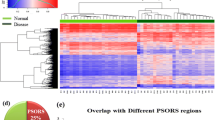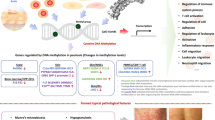Abstract
SHP-1 promoter hypermethylation has been studied in hematopoietic cells and observed only in various types of lymphoma and leukemia. This study reports a contrasting situation in normal epithelial tissues and an association with skin pathogenesis, particularly in psoriasis. We investigated several cell lines, five of them were epithelial and six were hematopoietic, white blood cells from normal, healthy donors, and normal microdissected epithelium of kidney, liver, breast, cervix, lung, prostate, bladder, and skin. Interestingly, promoter 2 hypermethylation was apparent in all epithelial cell lines and tissues. However, distinctive degrees of demethylation were noted in some skin samples. The methylation patterns of each cell line corresponded to their mRNA isoforms, in that isoforms I and II could not be detected with either promoter 1 or 2 hypermethylation, respectively. We further explored whether an enhanced degree of demethylation could be observed in various dermatopathology lesions. While the promoter 2 methylation levels of squamous cell cancers, eczemas, and normal skins were not different, a significant degree of demethylation can be observed in psoriasis (p<0.005). In addition, psoriasis displays a higher level of SHP-1 isoform II than normal skin (p<0.05). In conclusion, this study discovered an unprecedented role of SHP-1 methylation in tissue-specific expression and its alteration in a nonmalignant human disease besides the transcription inhibition in leukemia and lymphoma. Furthermore, the promoter demethylation may play an important role in skin pathogenesis by enhancing SHP-1 isoform II transcription in psoriatic skin lesions.




Similar content being viewed by others
Abbreviations
- SCC:
-
Squamous cell carcinoma
- COBRA:
-
combined bisulfite restriction analysis
- MSP:
-
methylation-specific PCR
References
Bruecher-Encke B, Griffin JD, Neel BG, Lorenz U (2001) Role of the tyrosine phosphatase SHP-1 in K562 cell differentiation. Leukemia 15:1424–1432
Zapata PD, Ropero RM, Valencia AM et al (2002) Autocrine regulation of human prostate carcinoma cell proliferation by somatostatin through the modulation of the SH2 domain containing protein tyrosine phosphatase (SHP)-1. J Clin Endocrinol Metab 87:915–926
Zhang Q, Raghunath PN, Vonderheid E, Odum N, Wasik MA (2000) Lack of phosphotyrosine phosphatase SHP-1 expression in malignant T-cell lymphoma cells results from methylation of the SHP-1 promoter. Am J Pathol 157:1137–1146
Oka T, Yoshino T, Hayashi K et al (2001) Reduction of hematopoietic cell-specific tyrosine phosphatase SHP-1 gene expression in natural killer cell lymphoma and various types of lymphomas/leukemias: combination analysis with cDNA expression array and tissue microarray. Am J Pathol 159:1495–1505
Ching TT, Maunakea AK, Jun P et al (2005) Epigenome analyses using BAC microarrays identify evolutionary conservation of tissue-specific methylation of SHANK3. Nat Genet 37:645–651
Song F, Smith JF, Kimura MT et al (2005) Association of tissue-specific differentially methylated regions (TDMs) with differential gene expression. Proc Natl Acad Sci U S A 102:3336–3341
Yip SS, Crew AJ, Gee JM et al (2000) Up-regulation of the protein tyrosine phosphatase SHP-1 in human breast cancer and correlation with GRB2 expression. Int J Cancer 88:363–368
Mok SC, Kwok TT, Berkowitz RS, Barrett AJ, Tsui FW (1995) Overexpression of the protein tyrosine phosphatase, nonreceptor type 6 (PTPN6), in human epithelial ovarian cancer. Gynecol Oncol 57:299–303
Wu C, Sun M, Liu L, Zhou GW (2003) The function of the protein tyrosine phosphatase SHP-1 in cancer. Gene 306:1–12
Yi TL, Cleveland JL, Ihle JN (1992) Protein tyrosine phosphatase containing SH2 domains: characterization, preferential expression in hematopoietic cells, and localization to human chromosome 12p12-p13. Mol Cell Biol 12:836–846
Banville D, Stocco R, Shen SH (1995) Human protein tyrosine phosphatase 1C (PTPN6) gene structure: alternate promoter usage and exon skipping generate multiple transcripts. Genomics 27:165–173
Zhang Q, Wang HY, Marzec M, Raghunath PN, Nagasawa T, Wasik MA (2005) STAT3- and DNA methyltransferase 1-mediated epigenetic silencing of SHP-1 tyrosine phosphatase tumor suppressor gene in malignant T lymphocytes. Proc Natl Acad Sci U S A 102:6948–6953
Sano S, Chan KS, Carbajal S et al (2005) Stat3 links activated keratinocytes and immunocytes required for development of psoriasis in a novel transgenic mouse model. Nat Med 11:43–49
Chaturvedi V, Qin JZ, Denning MF, Choubey D, Diaz MO, Nickoloff BJ (1999) Apoptosis in proliferating, senescent, and immortalized keratinocytes. J Biol Chem 274:23358–23367
Nickoloff BJ, Nestle FO (2004) Recent insights into the immunopathogenesis of psoriasis provide new therapeutic opportunities. J Clin Invest 113:1664–1675
Green MR (2004) Targeting targeted therapy. N Engl J Med 350:2191–2193
Chalitchagorn K, Shuangshoti S, Hourpai N et al (2004) Distinctive pattern of LINE-1 methylation level in normal tissues and the association with carcinogenesis. Oncogene 23:8841–8846
Mutirangura A, Charuruks N, Shuangshoti S et al (1999) Identification of distinct regions of allelic loss on chromosome 13q in nasopharyngeal cancer from paraffin embedded tissues. Int J Cancer 83:210–214
Herman JG, Graff JR, Myohanen S, Nelkin BD, Baylin SB (1996) Methylation-specific PCR: a novel PCR assay for methylation status of CpG islands. Proc Natl Acad Sci U S A 93:9821–9826
Koyama M, Oka T, Ouchida M et al (2003) Activated proliferation of B-cell lymphomas/leukemias with the SHP1 gene silencing by aberrant CpG methylation. Lab Invest 83:1849–1858
Xiong Z, Laird PW (1997) COBRA: a sensitive and quantitative DNA methylation assay. Nucleic Acids Res 25:2532–2534
Wongpiyabovorn J, Suto H, Ushio H et al (2003) Up-regulation of interleukin-13 receptor alpha1 on human keratinocytes in the skin of psoriasis and atopic dermatitis. J Dermatol Sci 33:31–40
Bird AP, Wolffe AP (1999) Methylation-induced repression-belts, braces, and chromatin. Cell 99:451–454
Jones PA, Takai D (2001) The role of DNA methylation in mammalian epigenetics. Science 293:1068–1070
Reik W, Dean W, Walter J (2001) Epigenetic reprogramming in mammalian development. Science 293:1089–1093
Shiota K, Kogo Y, Ohgane J et al (2002) Epigenetic marks by DNA methylation specific to stem, germ and somatic cells in mice. Genes Cells 7:961–969
Feinberg AP (2004) The epigenetics of cancer etiology. Semin Cancer Biol 14:427–432
Das PM, Singal R (2004) DNA methylation and cancer. J Clin Oncol 22:4632–4642
He B, You L, Uematsu K et al (2003) SOCS-3 is frequently silenced by hypermethylation and suppresses cell growth in human lung cancer. Proc Natl Acad Sci U S A 100:14133–14138
Dammann R, Li C, Yoon JH, Chin PL, Bates S, Pfeifer GP (2000) Epigenetic inactivation of a RAS association domain family protein from the lung tumour suppressor locus 3p21.3. Nat Genet 25:315–319
Lorenz U, Bergemann AD, Steinberg HN et al (1996) Genetic analysis reveals cell type-specific regulation of receptor tyrosine kinase c-Kit by the protein tyrosine phosphatase SHP1. J Exp Med 184:1111–1126
Paulson RF, Vesely S, Siminovitch KA, Bernstein A (1996) Signalling by the W/Kit receptor tyrosine kinase is negatively regulated in vivo by the protein tyrosine phosphatase Shp1. Nat Genet 13:309–315
Paling NR, Welham MJ (2002) Role of the protein tyrosine phosphatase SHP-1 (Src homology phosphatase-1) in the regulation of interleukin-3-induced survival, proliferation and signalling. Biochem J 368:885–894
Minoo P, Zadeh MM, Rottapel R, Lebrun JJ, Ali S (2004) A novel SHP-1/Grb2-dependent mechanism of negative regulation of cytokine-receptor signaling: contribution of SHP-1 C-terminal tyrosines in cytokine signaling. Blood 103:1398–1407
Chen HE, Chang S, Trub T, Neel BG (1996) Regulation of colony-stimulating factor 1 receptor signaling by the SH2 domain-containing tyrosine phosphatase SHPTP1. Mol Cell Biol 16:3685–3697
Wrone-Smith T, Nickoloff BJ (1996) Dermal injection of immunocytes induces psoriasis. J Clin Invest 98:1878–1887
McKenzie RC, Sabin E (2003) Aberrant signalling and transcription factor activation as an explanation for the defective growth control and differentiation of keratinocytes in psoriasis: a hypothesis. Exp Dermatol 12:337–345
Acknowledgements
This work was supported in part by grants from the Royal Golden Jubilee Ph.D. grant, the Thailand Research Funds, Molecular Biology and Genetics of Cancer Development Research Unit, Chulalongkorn University, and National Center for Genetic Engineering and Biotechnology, Thailand. For cell lines, we thank Professor Hedeoki Ogawa for kindly providing HaCaT, Dr. Chintana Chirathaworn for U937 and Molt4, Dr. Virote Sriuranpong for Hela and SW480, Dr. Watchara Kasinrerk for Daudi, Jurkat, and K562, and Dr. Pokrath Hansasura for both BLCLs. We also would like to express our gratitude to the Department of Pathology, Dermatology Unit, Department of Medicine, and our professor, Dr. Nopadon Noppakun, for paraffin tissues and clinical information. Finally, we would like to thank Ms. Petra Hirsch for critically reviewing the manuscript.
Author information
Authors and Affiliations
Corresponding author
Rights and permissions
About this article
Cite this article
Ruchusatsawat, K., Wongpiyabovorn, J., Shuangshoti, S. et al. SHP-1 promoter 2 methylation in normal epithelial tissues and demethylation in psoriasis. J Mol Med 84, 175–182 (2006). https://doi.org/10.1007/s00109-005-0020-6
Received:
Accepted:
Published:
Issue Date:
DOI: https://doi.org/10.1007/s00109-005-0020-6




